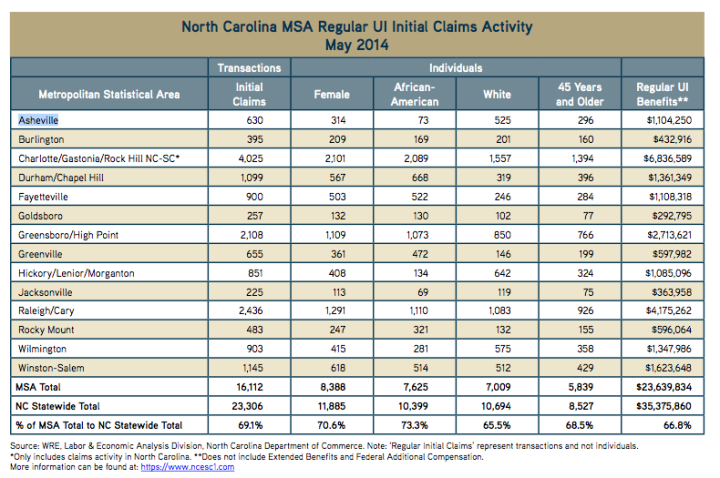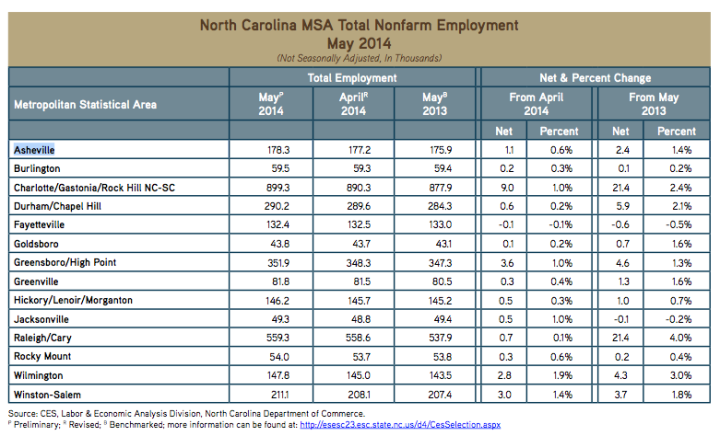From the North Carolina Department of Commerce – Labor and Economic Analysis Division:
RALEIGH — The state’s seasonally adjusted May unemployment rate was 6.4 percent, increasing 0.2 of a percentage point from April’s revised rate of 6.2 percent. The national rate remained unchanged at 6.3 percent.
North Carolina’s May 2014 unemployment rate was 1.9 percentage points lower than a year ago. The number of people employed increased 10,187 over the month to 4,397,574, and increased 81,992 over the year. The number of people unemployed increased 8,795 over the month to 300,917, and declined 90,299 over the year.
Seasonally adjusted Total Nonfarm industry employment, as gathered through the monthly establishment survey, increased 5,700 to 4,122,300 in May. The major industry with the largest over-the-month increase was Leisure & Hospitality Services at 7,400, followed by Trade, Transportation & Utilities, 2,300; Education & Health Services, 1,800; Construc- tion, 400; Mining & Logging, 100; and Other Services, 100. Major industries experiencing decreases were Professional & Business Services, 3,400; Manufacturing, 2,200; Government, 400; Information, 200; and Financial Activities, 200.
Since May 2013, Total Nonfarm jobs gained 77,600 with the Total Private sector growing by 79,300 and Government declining by 1,700. The largest over-the-year increase of major industries was Professional & Business Services at 27,000, followed by Trade, Transportation & Utilities, 19,700; Leisure & Hospitality Services, 12,100; Education & Health Services, 7,500; Construction, 5,100; Other Services, 4,200; Information, 3,000; and Financial Activities, 1,000. Major industries experiencing decreases over the year were Government, 1,700; and Manufacturing, 300. Mining & Logging employment remained unchanged over the year.
The next unemployment update is scheduled for Tuesday, July 1, 2014 when the county unemployment rates for May 2014 will be released.

Unemployment at a Glance from NC Today, June 2014:
Civilian Labor Force
- North Carolina’s May 2014 smoothed seasonally adjusted unemployment rate, at 6.4 percent, increased 0.2 of apercentage point from April 2014. The rate was 8.3 percent in May 2013.
- At 6.4 percent, North Carolina’s May unemployment rate is 0.1 of a percentage point higher than the United States’ 6.3 percent rate.
- Over the month, the number of people unemployed increased 3.0 percent to 300,917.
- During May, North Carolina’s smoothed seasonally adjusted labor force participation rate increased 0.2 of a percentage point to 61.3 percent, while the U.S. rate was unchanged at 62.8 percent.
Nonfarm Employment
- Seasonally adjusted Total Nonfarm employment for May 2014 rose by 5,700 jobs over the month, and 77,600over the year to 4,122,300.
- Over the month, six sectors experienced seasonally adjusted job growth: Leisure & Hospitality Services, 7,400; Trade, Transportation & Utilities, 2,300; Education & Health Services, 1,800; Construction, 400; Mining & Logging, 100; and Other Services, 100. Losses were reported by Professional & Business Services, 3,400; Manufacturing, 2,200; Government, 400; Financial Activities, 200; and Information, 200.
- The major sectors to report over-the-year seasonally adjusted job increases were: Professional & Business Services, 27,000; Trade, Transportation & Utilities, 19,700; Leisure & Hospitality Services, 12,100; Education & Health Services, 7,500; Construction, 5,100; Other Services, 4,200; Information, 3,000; and Financial Activities, 1,000.
- Not seasonally adjusted, the following major sectors reported over-the-year job growth: Professional & Business Services, 29,900; Trade, Transportation & Utilities, 19,700; Leisure & Hospitality Services, 12,400; Education & Health Services, 6,300; Other Services, 4,200; Construction, 3,500; Financial Activities, 2,600; Information, 2,100; and Manufacturing, 200.
- The following sectors in Manufacturing showed not seasonally adjusted over-the-year job increases: Chemical, 1,600; Wood Product, 1,200; Furniture & Related Product, 1,000; Transportation Equipment, 1,000; Machinery, 500; Fabricated Metal Product, 200; Plastics & Rubber Products, 200; and Food, 100. Losses were reported in the remaining sectors: Computer & Electronic Product, 1,200; Beverage & Tobacco Product, 900; Apparel, 600; Textile Product Mills, 600; Electrical Equipment, Appliance & Component, 500; Textile Mills, 400; and Printing & Related Support Activities reported no change.
- Food remains North Carolina’s leading sector in manufacturing employment at 51,700. Chemical follows with 43,700.
Other Information
- Preliminary Average Hourly Earnings in North Carolina for manufacturing production workers increased 8 cents to $16.80 in May; Average Weekly Hours decreased 24 minutes to 43.2 from 43.6. Average Weekly Earnings dropped $3.23 to $725.76.
- North Carolina paid $36.5 million in Unemployment Insurance benefits (all programs) to claimants in May. These payments include state and federally funded benefits.
- The number of Initial Claims filed in North Carolina for Unemployment Insurance benefits increased in
May to 23,306. Approximately $35.4 million was paid in regular UI benefits to 42,382 unemployed persons across the state. The average weekly benefit amount was $223.16 (maximum weekly benefit is $350), which does not include the $25 Federal Additional Compensation (FAC) payment from The American Recovery and Reinvestment Act.

In not seasonally adjusted data, 13 of 14 Metropolitan Statistical Areas (MSAs) experienced Total Nonfarm employment growth in May. The Charlotte/Gastonia/Rock Hill MSA posted the largest over-the-month increase of 9,000 jobs. The only loss was in the Fayetteville MSA, which decreased by 100 jobs.
Mining & Logging and Construction employment increased or remained unchanged in all but one MSA this month. Charlotte/Gastonia/Rock Hill posted the largest gain with 700 jobs, while Winston-Salem had the only loss at 100 jobs.
Manufacturing employment varied across the MSAs this month. Four MSAs — Greensboro/High Point, Greenville, Rocky Mount, and Winston-Salem — showed a gain of 100 jobs each. Charlotte/Gastonia/Rock Hill and Raleigh/Cary both posted losses of 200 jobs each.
Trade, Transportation & Utilities employment varied across the MSAs this month. Charlotte/Gastonia/Rock Hill reported the largest over-the-month gain of 1,700 jobs, while Raleigh/Cary had the largest loss at 600 jobs.
Information employment experienced a change in only one MSA in May. Charlotte/Gastonia/Rock Hill gained 100 jobs.
Financial Activities employment experienced change in only three MSAs. Greensboro/High Point, Raleigh/Cary, and Wilmington each gained 100 jobs.
Professional & Business Services employment varied across the MSAs over the month. Greensboro/High Point posted the largest job increase at 800. Administrative, Support, Waste Management & Remediation was responsible for all of the gain. Raleigh/Cary had the greatest loss over the month at 300 jobs as a result of a 1,000 job loss in Professional, Scientific & Technical Services and a gain of 700 jobs in Administrative, Support, Waste Management & Remediation Services.
Education & Health Services employment varied across the MSAs this month. Durham/Chapel Hill posted the greatest gain at 700 jobs, followed by Winston-Salem with 600. Greensboro/High Point had the greatest loss at 300 jobs.
Leisure & Hospitality Services employment increased in all but one MSA over the month. Charlotte/Gastonia/Rock Hill had the largest gain at 5,700 jobs, while Greenville posted the largest loss at 100 jobs.
Other Services employment increased or remained the same across all MSAs over the month. Raleigh/Cary reported the largest gain at 400 jobs.
Government employment varied across the MSAs over the month. Charlotte/Gastonia/Rock Hill had the largest gain at 500 jobs with all of it coming from Local Government. Raleigh/Cary posted the greatest loss at 1,300 jobs, followed by Durham/Chapel Hill at 1,000. All of the job losses came from State Government.




My Home Land Scotland is facing highest Unemployment Rate. I wish I’m able to do something… But thanks for sharing these statistics. It’ll be nice that our generation think & take step about these abominable facts.